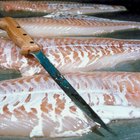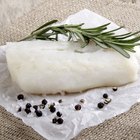lisaaMC/iStock/GettyImages
Freezing fresh halibut is one of the best ways to preserve this healthy fish to enjoy at a later date. Employing proper freezing practices ensures that, once thawed, your halibut tastes almost as fresh as the day it came out of the ocean. Freezing halibut fillets in individual portions not only quickens thawing time, but allows you to defrost only what you need for your meal.
Storage Times
The USDA recommends keeping uncooked fish for no longer than one to two days in the fridge and six months in the freezer. Cooked halibut fillets can keep three to four days in the fridge and four to six months in the freezer. Smoked fish, including smoked halibut, has a different shelf-life of up to 14 days in the fridge and two months in the freezer.
Halibut Selection
The selection of halibut fillets is almost as important as using the proper freezing methods. Look for halibut displayed on a layer of ice over pre-packaged fillets sitting in Styrofoam and plastic wrap. Visually, the halibut should have a beautiful white hue. Avoid any fillets that have any browning or gaping within the fillet. Check halibut fillets for a fresh salt-water smell, and refrain from purchasing any cuts that smell "fishy."
Freezing Preparation
Freezing your halibut fillets greatly increases the length of time you have to consume the fish. In fact, freezing food at 0 degrees Fahrenheit keeps food indefinitely safe, because bacteria is no longer able to grow and spoil the fillets. However, without using proper freezing methods, though the fish is technically save to eat, the quality suffers if not frozen properly. For example, ice crystals or freezer burn can damage the fillet.
Freezing Methods
For proper freezing of halibut, pre-treat the fillets to protect from excess moisture loss during the thawing process. Combine 1/4 cup of salt with a quart of cold water and dip the halibut fillet in the mixture for about 20 seconds. The solution helps firm the fish. Next, form an "ice glaze" around the fish to seal in the freshness: freeze the fillet, dip it in ice water and return to the freezer, repeating the process several times until an even layer of ice forms over the fish. For proper storage, wrap in moisture paper individually and place in a sealable bag and return to the freezer until ready for use. Or vacuum seal your halibut fillets; by removing the air before freezing, both dehydration and the oxidation of the fillets are avoided, resulting in a fresher fish upon thawing.
Proper Thawing
Performing the proper thawing methods helps preserve the quality of the halibut and gets it ready it for the cooking process. Thaw halibut by placing it in a tray with drain holes and storing it at between 32 and 35 degrees Fahrenheit. Refrigerators commonly are set at slightly above that temperature at 40 degrees Fahrenheit. Adjust the temperature of the fridge accordingly to meet this requirement. Fillets take about 12 hours to defrost using this method.
Related Articles

How Long Does Tilapia Last Refrigerated?

How to Freeze Cod Fish

Baking Partially Frozen Salmon

How to Freeze Catfish

How to Smoke Carp

How to Make a Batter for Baking Fish

How Long Does It Take for Salmon to ...

How to Cook Frozen Salmon Fillets ...

How to Grill a Cod Fish

The Best Way to Smoke Yellowtail
How to Bake Salmon So It's Tender

How to Pickle Fish

How to Brine Trout to Smoke
How to Cook Atlantic Cod Fillets

How to Cook Rockfish Fillets

How to Defrost Cod

How to Brine a Grilled Salmon

How to Cook Frozen, Boneless & Skinless ...

Fish Cooking Temperature

Can You Cook Frozen Salmon Whole?
References
Writer Bio
Scott Damon is a Web content specialist who has written for a multitude of websites dating back to 2007. Damon covers a variety of topics including personal finance, small business, sports, food and travel, among many others.